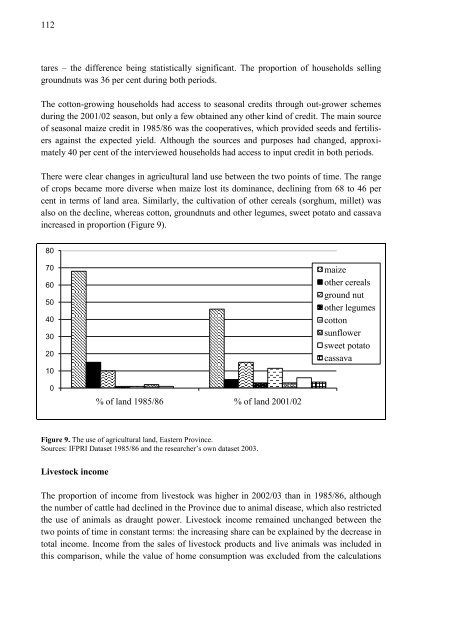Rural Income Generation and Diversification - A Case Study ... - Doria
Rural Income Generation and Diversification - A Case Study ... - Doria
Rural Income Generation and Diversification - A Case Study ... - Doria
You also want an ePaper? Increase the reach of your titles
YUMPU automatically turns print PDFs into web optimized ePapers that Google loves.
112<br />
tares – the difference being statistically significant. The proportion of households selling<br />
groundnuts was 36 per cent during both periods.<br />
The cotton-growing households had access to seasonal credits through out-grower schemes<br />
during the 2001/02 season, but only a few obtained any other kind of credit. The main source<br />
of seasonal maize credit in 1985/86 was the cooperatives, which provided seeds <strong>and</strong> fertilisers<br />
against the expected yield. Although the sources <strong>and</strong> purposes had changed, approximately<br />
40 per cent of the interviewed households had access to input credit in both periods.<br />
There were clear changes in agricultural l<strong>and</strong> use between the two points of time. The range<br />
of crops became more diverse when maize lost its dominance, declining from 68 to 46 per<br />
cent in terms of l<strong>and</strong> area. Similarly, the cultivation of other cereals (sorghum, millet) was<br />
also on the decline, whereas cotton, groundnuts <strong>and</strong> other legumes, sweet potato <strong>and</strong> cassava<br />
increased in proportion (Figure 9).<br />
80<br />
70<br />
60<br />
50<br />
40<br />
30<br />
20<br />
10<br />
0<br />
Figure 9. The use of agricultural l<strong>and</strong>, Eastern Province.<br />
Sources: IFPRI Dataset 1985/86 <strong>and</strong> the researcher’s own dataset 2003.<br />
Livestock income<br />
% of l<strong>and</strong> 1985/86 % of l<strong>and</strong> 2001/02<br />
maize<br />
other cereals<br />
ground nut<br />
other legumes<br />
cotton<br />
sunflower<br />
sweet potato<br />
cassava<br />
The proportion of income from livestock was higher in 2002/03 than in 1985/86, although<br />
the number of cattle had declined in the Province due to animal disease, which also restricted<br />
the use of animals as draught power. Livestock income remained unchanged between the<br />
two points of time in constant terms: the increasing share can be explained by the decrease in<br />
total income. <strong>Income</strong> from the sales of livestock products <strong>and</strong> live animals was included in<br />
this comparison, while the value of home consumption was excluded from the calculations

















